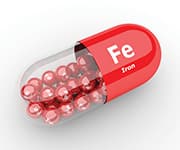Life Extension Magazine®
Taurine Ranked as Top Supplement
Longevity and regenerative medicine doctor Neil Paulvin identified taurine as the top anti-aging supplement in an article published on CNBC.1He said he has been taking it daily for the past several years and has noticed its benefits.
Taurine is one of the most abundant amino acids in the body. It is found in most tissues, including the heart, liver, kidneys, and brain.Its presence in these areas helps promote a healthy heart and brain, cell membrane stability, healthy insulin response and nervous system function, and more.2
Studies show that taurine promotes vasodilation, which helps improve blood flow and reduces blood pressure levels. It helps the body's mitochondria function properly. It can also boost brain function, support healthy muscles, and help repair DNA damage.
One population study of 25 countries found that people living in Okinawa, Japan, had the highest intake of taurine.2 They also had the lowest rate of heart disease among the countries studied—and the longest lifespan.
Although the body produces a small amount of taurine, production declines with age and is insufficient to maintain optimal health.3
Editor's Note: "I personally take about 2,000 mg per day," Dr. Paulvin said, "but for those new to taurine supplements, I recommend starting with a lower dosage—around 500 to 1,000 mg—and then working your way up. Of course, it's always best to consult with a physician before starting any new supplement."
References
- Available at: https://www.cnbc.com/2023/10/27/longevity-doctor-says-this-is-the-no-1-supplement-he-takes-every-day-to-slow-down-aging.html. Accessed January 22, 2024
- Adv Exp Med Biol. 2009;643:13-25.
- Mol Med Rep. 2021 8;24(2):605.
Omega-3 Helps Support Healthy Inflammatory Response in Long-Distance Runners
Intake of omega-3 fatty acids by long-distance runners offers protection against an increased inflammatory response to exercise-induced injury, a recent study found.* The authors noted that marathon runners are at risk of muscle injury and heart arrhythmias and dysfunction.
The study included 24 long-distance runners who received 3,000 mg omega-3 fatty acids or a placebo daily for three weeks. Cardiac markers and inflammatory cytokines were measured in blood obtained before, immediately after, one hour after, and 24 hours after exercise tests that were conducted prior to and at the end of the three-week treatment period.
In the omega-3 group, the Omega-3 Index, erythrocyte membrane omega-3 and HDL levels were higher, and triglycerides were lower after three weeks, compared with before the treatment period. Following treatment, in this group, compared to post-exercise levels measured prior to the treatment period, inflammation mediators and markers of cardiac damage were lower and adiponectin increased following the exercise test.
Editor's Note: Research has found that endurance training is associated with a reduction in erythrocyte (red blood cell) omega-3 fatty acids. Omega-6 polyunsaturated fatty acid-derived lipid mediators released in response to exercise-induced muscle damage promote inflammation. Additionally, indicators of cardiac damage increase following marathon participation. Although these markers return to normal within 48 hours, repetitive increases may have long-term adverse effects.
* J Hum Kinet. 2023 Oct 27:89:123-138.
Vitamin B6 Reduces Adverse Reactions from H. pylori Treatment
Findings from a recent clinical trial suggest that vitamin B6 could help decrease adverse reactions associated with the main eradication therapy for Helicobacter pylori (H. pylori) infection.*
The two-week trial included 280 men and women diagnosed with H. pylori. Half of the participants were randomized to receive the standard "quadruple therapy treatment" which consists of a proton pump inhibitor, a bismuth agent, tetracycline, and metronidazole. The other 130 participants received the same treatment with the addition of 20 mg of vitamin B6 twice per day. At the end of the treatment period, participants were given a breath test to determine whether treatment for H. pylori was successful.
The percentages of H. pylori eradication in each group were statistically similar. But while 74.62% of the group that received H. pylori treatment alone experienced adverse reactions, these effects occurred among only 56.92% of those whose treatment was combined with vitamin B6. Dizziness, headache, and loss of muscle coordination occurred in 58.7% of the group that did not receive vitamin B6 and in only 14.63% of the B6 group. None of those who received B6 experienced any moderate or severe gastrointestinal symptoms, compared with a third of the group that did not receive the vitamin.
Editor's Note: "H. pylori infection is one of the most common bacterial infections, affecting approximately 50% of the global population," the authors stated.
* BMC Infect Dis. 2023 Sep 11;23(1):590.
Coffee, Tea Drinking at Midlife Linked with Less Frailty in Later Years
A study revealed an association between drinking coffee or tea during middle-age and less physical frailty in older age, in a dose-response relationship.*
The study included 12,583 men and women, average age 53 on enrollment, from 1993–1998. Questionnaires obtained information concerning their intake of caffeinated beverages. Participants were weighed at the second follow-up, during 2006–2010. At the third follow-up, during 2014–2017, energy levels and handgrip strength were evaluated and timed up-and-go testing was conducted.
The results showed that that the odds of physical frailty at the third year follow-up were 46% lower for coffee drinkers compared to the odds of frailty in those who drank no coffee. The odds of frailty were also 18% lower among daily tea drinkers compared to the odds of frailty in those who consumed it less than once a month.
Editor's Note: "…physical frailty was assessed using a modified version of the Cardiovascular Health Study frailty phenotype that included weight loss, exhaustion, slowness, and weakness," the authors stated.
* J Am Med Dir Assoc. 2023 Jul 21:S1525-8610(23)00575-3.
Iron Deficiency, Iron-Deficiency Anemia Prevalent in U.S. Females 12-21
A recent study found that the prevalence of iron deficiency and anemia in teen girls and young women is high enough to warrant routine screening of this group for these conditions. Iron deficiency is not routinely checked in this age group and instead, only non-pregnant female adolescents and women are screened every 5-10 years for anemia by measuring hemoglobin.*
The study was comprised of 3,490 girls and women aged 12–21 who were enrolled in the National Health and Nutrition Examination Survey (NHANES). Iron deficiency was defined as a ferritin level of less than 25 mcg/L and iron-deficiency anemia was defined as ferritin of less than 25 mcg/L and hemoglobin of less than 12 mg/dL.
Iron deficiency was found in 38.6% of the group, and 6.3% had iron-deficiency anemia. While menstruation was a risk factor for both conditions, over 25% of the girls who were not yet menstruating were deficient.
Editor's Note: "Although screening for anemia by measurement of hemoglobin level is recommended, there is benefit in identifying and treating iron deficiency in those without anemia because supplementation improves exercise performance and reduces fatigue, and iron deficiency is associated with increased all-cause mortality," the authors wrote.
* JAMA. 2023 Jun 27;329(24):2191-2193.





